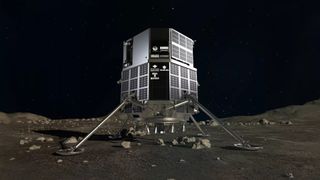SpaceX delays launch of Japanese moon lander for last-minute rocket checks
SpaceX says the delay was to allow for "additional pre-flight checkouts."

SpaceX stood down from an early morning launch on Wednesday (Nov. 30) that would have sent Japan's Hakuto-R lunar lander and its United Arab Emirates rover toward the moon.
The instantaneous launch window was scheduled for 3:39 a.m. (0839 GMT) on Wednesday (Nov. 30), but SpaceX announced the delay in a tweet just over four hours before lift-off. "Standing down from launch of ispace's HAKUTO-R Mission 1 to allow for additional pre-flight checkouts," company representatives wrote.
The launch is now scheduled for another instantaneous window on Thursday (Dec. 1) at 3:37 a.m. EST (0837 GMT) from Florida's Cape Canaveral Space Force Station. You can watch live here at Space.com, courtesy of SpaceX, or directly via the company. Coverage will begin about 15 minutes before launch.
Related: Japanese ispace lander to carry UAE moon rover to lunar surface in 2022
When Hakuto-R launches, it will embark on a nearly four-month journey to the moon, which will result in the first-ever soft touchdown by a private company on the lunar surface if all goes according to plan. After the lander is safely on the lunar surface, it will deploy Rashid, a small rover built by the United Arab Emirates (UAE).
The 22-pound (10-kilogram), four-wheeled rover will traverse the moon for one lunar day (14 Earth days) while collecting data about the lunar surface. Rashid is equipped with a high-resolution camera, thermal and microscopic imaging tools, and a probe that will allow it to study the electrically charged environment of the lunar surface. Scientists believe this electrical charge is created by the solar wind, a flow of charged particles constantly streaming off the sun.

The mission will be the first for ispace, which has been developing Hakuto-R for more than a decade after being established in 2010. The company has a second lunar mission planned for 2023, also expected to launch aboard a SpaceX Falcon 9 rocket, ispace representatives have said.
Get the Space.com Newsletter
Breaking space news, the latest updates on rocket launches, skywatching events and more!
The UAE, meanwhile, has ambitious plans for its space program. Hope, the nation's first Mars probe, began orbiting the Red Planet in February 2021, and the nation's space agency aims to establish a colony on Mars by 2117.
Ispace's Hakuto-R lander was originally intended to land on the moon in 2021, but was delayed due to technical issues. The company hopes to eventually enable the development of settlements on the moon using water ice mined from the lunar surface.
Follow Brett on Twitter at @bretttingley. Follow us on Twitter @Spacedotcom or on Facebook.
Join our Space Forums to keep talking space on the latest missions, night sky and more! And if you have a news tip, correction or comment, let us know at: community@space.com.

Brett is curious about emerging aerospace technologies, alternative launch concepts, military space developments and uncrewed aircraft systems. Brett's work has appeared on Scientific American, The War Zone, Popular Science, the History Channel, Science Discovery and more. Brett has English degrees from Clemson University and the University of North Carolina at Charlotte. In his free time, Brett enjoys skywatching throughout the dark skies of the Appalachian mountains.
